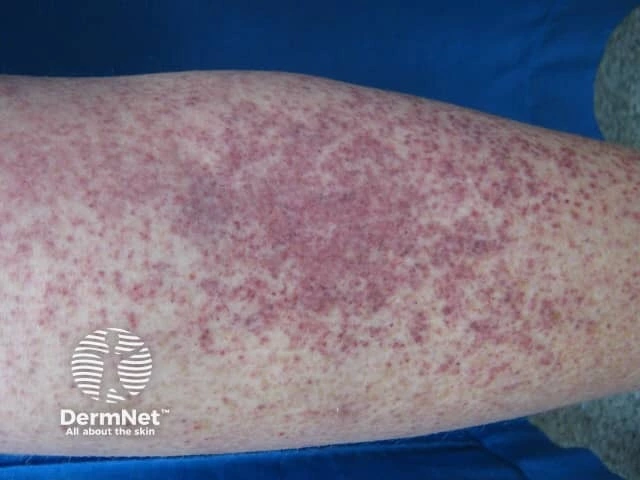Complications of Untreated ITP: 4 Signs To Look for and 6 Ways To Manage Them


Key Takeaways
- Immune thrombocytopenia (ITP) is a rare autoimmune condition where the body destroys platelets faster than it can make new ones, leading to easy bruising and bleeding problems. View full summary
This is a member-feature!
Sign up for free to view the full article summary.
 Continue with Facebook
Sign up with your email
Continue with Facebook
Sign up with your email
You probably don’t think much about your platelets, the tiny cells that help stop bleeding when you get a cut or scrape. But if you have immune thrombocytopenia (ITP), your body doesn’t make or keep enough of them because your immune system destroys them faster than it can make new ones.
This rare condition can cause easy bruising, nosebleeds, or other bleeding problems.
Left untreated, ITP can lead to serious complications. Fortunately, treatment and lifestyle changes can help reduce the risk of complications down the road.
ITP is an autoimmune disease that happens when the immune system attacks platelets. Platelets are small blood cells that stick together in places where blood vessels are damaged. If you don’t have enough platelets (as with ITP), blood can’t properly clot to stop bleeding.
In this article, we’ll talk about some of the common signs of ITP and how to manage them.
What Are the Signs of ITP?
At first, ITP can be asymptomatic, which means that there won’t be any obvious symptoms. Sometimes, it’s only discovered by chance when someone takes a blood test for other reasons. Platelet counts can sometimes be very low by the time ITP is recognized and diagnosed. Treating ITP as early as possible can help prevent complications. Tell your healthcare provider right away if you notice any of the following signs of ITP.
1. Easy Bruising
Bruises develop when bleeding occurs under the skin from a hard impact. People with ITP may develop large bruises from ordinary activities. Bruises may appear on the elbows and knees in particular, but they can show up anywhere on the body. Bruises called purpura can also develop due to bleeding from blood vessels under the skin. They may appear purple or brown, depending on skin tone.
2. Bleeding Within the Skin
With ITP, your skin can develop tiny red or discolored spots called petechiae. They may look like a rash, but they’re actually a type of superficial bleeding in the skin. Petechiae do not itch like a typical rash, which is an important sign that they may be a complication of ITP. Petechiae often appear on the lower legs.

3. Excessive Bleeding
It’s easy to brush off nosebleeds or bleeding gums as nothing unusual, but with ITP, the bleeding can be heavier and harder to stop. In addition, rectal bleeding or blood in the urine, stool, or vomit are signs of internal bleeding and possibly ITP.
4. Heavy Menstruation
The National Heart, Lung, and Blood Institute notes that women with ITP may have heavier-than-usual menstrual periods. Talk with your doctor if your period lasts more than seven days or has thick blood clots. If you need to change a pad or tampon more than once in two hours, that is also a sign of abnormally heavy bleeding. This could point to ITP or another serious condition. Heavy menstrual bleeding raises the risk of anemia and fatigue.
How Can You Manage ITP Complications?
People with ITP can take steps to stay safe and healthy using these six strategies.
1. Discuss Treatment Options With Your Doctor
If you or your child has ITP, talk with your hematologist about any questions or worries. Be an active member of your care team. Learn your options, share your goals and symptoms, and choose a plan together.
Some people with ITP who don’t have symptoms might not need any treatment. But it’s still important to monitor the condition. The most common first-line treatment for ITP is short-term use of glucocorticoids. Intravenous immunoglobulin is also an option.
If these don’t work, you can consider second-line treatment:
- Thrombopoietin-receptor agonists promote platelet production in bone marrow.
- Spleen tyrosine kinase inhibitors (SYK inhibitors) work by preventing the body’s immune system from attacking platelets.
- Other medications target the immune system to treat ITP and low platelet counts.
New treatments may become available as more research continues. If ITP treatment isn’t enough to keep you safe, your doctor may recommend surgery to remove your spleen.
2. Schedule Monitoring and Follow-Up Care
People with long-term ITP will need ongoing monitoring of their blood cell levels. If you take medication for ITP, you’ll need to be monitored for rare but serious side effects. Sticking to a treatment plan and follow-up care is essential for staying healthy with chronic ITP.
Be sure to keep your healthcare team informed about your symptoms. Don’t hesitate to contact your doctor if you think you or your child is having a serious symptom. ITP is linked to certain comorbidities or coinciding health conditions, so regular checkups are crucial.
3. Reduce Your Risk of Bleeding
People with ITP are advised to avoid contact sports that have a risk of injury, such as football, martial arts, and boxing. Avoid contact and high-impact activities, and use caution with higher-fall-risk activities (for example, skiing or cycling). Check with your care team about what activities are safe for you right now, and use safety equipment like helmets or wrist guards if needed. For young children with ITP, items such as soft bumpers on furniture or knee pads can help prevent injuries during play.
4. Adopt a Healthy Diet
Doctors believe a healthy diet can help with immune health. Eating more fresh fruits and vegetables, such as leafy greens, provides needed nutrients. Healthy fats, such as cold-pressed olive oil and canola oil, are good for your overall health. It is important to take iron-rich foods, as ITP can cause anemia (low hemoglobin levels) from blood loss.
Always talk to your doctor before taking herbal or dietary supplements. Some supplements could interact with your ITP medication or have a bad effect on your immune system.
Try making gradual changes rather than big changes all at once. Your doctor can provide a referral to a dietitian to help you with healthy meal planning.
5. Stay Physically Active and Exercise Safely
People with ITP may feel frustrated by precautions that limit their physical activity. But you can work with a physical therapist to learn ways to exercise safely and stay physically active.
Light or moderate activities like stretching, walking, gentle cycling, or resistance exercises with elastic bands are usually safe if your platelet count is high enough. Check with your care team to see what’s best for you.
6. Pay Attention to Your Psychological Well-Being
ITP can be emotionally challenging and interfere with daily life. People living with ITP have an increased risk of depression and anxiety. Mental health is an important part of maintaining a sense of well-being.
If you or someone you care for with ITP feels anxious, down, or stressed for a while, let your healthcare or hematology provider know. They can connect you with a counselor who understands chronic illness. Counseling can offer simple tools for coping, sleep, and mood. You can also ask about local or online support groups for practical tips and encouragement. Getting emotional support is an important part of living well with ITP.
Join the Conversation
On myITPcenter, people share their experiences with ITP, get advice, and find support from others who understand.
What ITP complications have you had, and how did you manage them? Let others know in the comments below.
- Immune Thrombocytopenia (ITP) — Mayo Clinic
- What Are Platelets and Why Are They Important? — Johns Hopkins Medicine
- Platelet Disorders: Thrombocytopenia — National Heart, Lung, and Blood Institute
- Heavy Menstrual Bleeding — Centers for Disease Control and Prevention
- Brain Bleed, Hemorrhage (Intracranial Hemorrhage) — Cleveland Clinic
- Primary Immune Thrombocytopenia: Novel Insights Into Pathophysiology and Disease Management — Journal of Clinical Medicine
- Optimal Use of Thrombopoietin Receptor Agonists in Immune Thrombocytopenia — Therapeutic Advances in Hematology
- Immune Thrombocytopenia (ITP) — Rare Disease Advisor
- Diet & Lifestyle — Platelet Disorder Support Association
- Vitamins and Other Supplements — Platelet Disorder Support Association
- Physical Exercise Is Safe and Feasible in Thrombocytopenic Patients With Hematologic Malignancies: A Narrative Review — Hematology
- Immune Thrombocytopenia: The Patient’s Perspective — Annals of Blood
Have You Experienced And Managed Complications From Untreated ITP? Share Your Insights










Christine2
I have lupus sle and Crohn's disease along with rheumatoid arthritis and recently I have been having nose bleeds several times a week and have developed small (very tiny- not clustered though) red dots on quite a few places on my body.... I'm off of all of my meds except for BP and siezure medications... This is troubling to me. Does it sound like ITP?